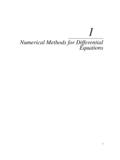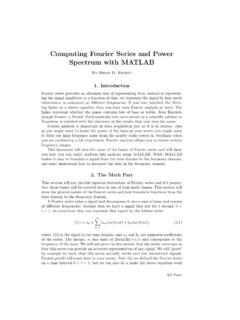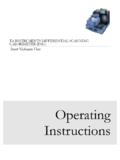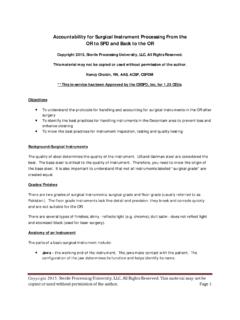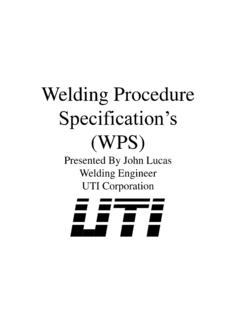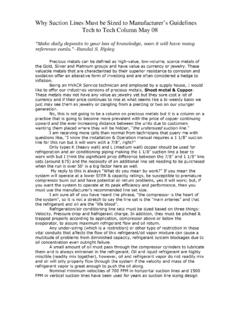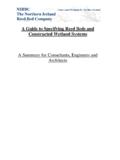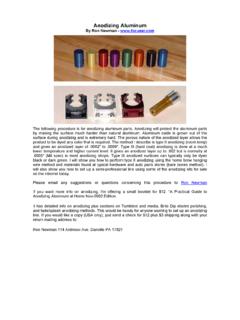Transcription of NEW Instron Universal operating instructions - Olin
1 Instron 5582 Universal TESTER Fat Tony operating instructions Instron 5582 Universal TESTER 1 Table of Contents Introduction 1 1 SAFETY Safety Hazards 1 Safety Precautions 1 2 BACKGROUND Background Information 2 The Tension Test 2 Metals 2 Polymers 4 The Flexure (Bend) Test 5 Ceramics 5 The Compression Test 6 References 6 3 OPERATION Grips Setup 7 Software Setup 7 Running the Test 8 Helpful Hints 11 Instron 5582 Universal TESTER 1 Introduction he Instron 5582 Universal Tester is a state-of-the-art testing machine that features a 100 kN load frame, a variety of specimen fixtures, several strain gauge extensometers, and Merlin software that is loaded with data collection and analysis features.
2 Specimen Geometry. The Instron Universal tester can handle a variety of specimen geometries. If you can find appropriate test fixtures in our supply cabinets, or design and fabricate your own test fixtures, you can probably test your sample. Test Fixtures. Our current stock of test fixtures includes the following: 3-Point Bend Setup for flexure testing. Platens for compression testing. Wedge Grips with various faces (for different specimen geometries) for tension testing. Safety Safety Hazards Fracture of brittle materials may result in projectiles. The Instron Universal Tester is capable of applying forces that can easily crush hands or other body parts, and the machine does not know or care if it s testing a steel rod or your fingers. Safety Precautions Always wear eye protection when working with or around the Universal tester. Move the yellow and black limit switches on the left column to positions close to the crosshead when changing fixtures to prevent accidental crushing of you or your specimen.
3 Keep all limbs clear of the machine when running tests. Stand away from the instrument while a test is running. Be careful when removing or adjusting the specimen grips. Some grips are quite heavy, and they parts of the grips may become loose and fall if improper adjustments are made. 1 T Instron 5582 Universal TESTER 2 Background Information A vast number of standardized tests are available for the measurement of mechanical properties. Three of the more common tests that may be easily performed with the Instron Universal Tester are tension testing, compression testing, and flexure testing. Each of these tests is used to determine how a material will respond to a particular type of loading. Depending on the type of test, the relevant output from the Instron may include load, displacement, stress, and strain data. The Tension Test NOTE: The following background text is taken directly or adapted from the Uniaxial Tension Testing section of ASM Handbook, Volume 8 Mechanical Testing and Evaluation.
4 The tension test is one of the most commonly used tests for evaluating materials. In its simplest form, the tension test is accomplished by gripping opposite ends of a test item within the load frame of a test machine. A tensile force is applied by the machine, resulting in the gradual elongation and eventual fracture of the test item. During this process, force-extension data, a quantitative measure of how the test item deforms under the applied tensile force, usually are monitored and recorded. When properly conducted, the tension test provides force-extension data that can quantify several important mechanical properties of a material. These mechanical properties determined from tension tests include, but are not limited to, the following: Elastic deformation properties, such as the modulus of elasticity (Young's modulus) and Poisson's ratio, Yield strength and ultimate tensile strength, Ductility properties, such as elongation and reduction in area, and Strain-hardening characteristics.
5 See Chapter 6 of your textbook for equations and information on analysis of stress/strain curves. The material characteristics determined from tension tests are used for quality control in production, for ranking performance of structural materials, for evaluation of newly developed alloys, and for dealing with the static-strength requirements of design. Tension tests are generally performed on metals and polymers. Ceramic materials, which are generally brittle, are difficult to grip in tension without causing damage or fracture, so flexure tests are more commonly used for ceramic materials. Metals Plastic deformation in metals is the result of the motion of large numbers of linear defects, or dislocations, in the material. The mechanical properties and stress-strain response of metals 2 Instron 5582 Universal TESTER 3 and alloys are largely a result of the ease at which dislocations can move in the material. If dislocation motion in a particular metal or alloy is difficult, the metal will experience very little strain before brittle fracture occurs.
6 If dislocation motion is easy, the material will behave in a ductile manner and exhibit a large amount of plastic deformation prior to failure. The chemical composition, mechanical processing, thermal processing (heat treatments), and the presence of defects will all affect the microstructure and mechanical properties of metals and alloys. Your instructor will provide a number of different metals and alloys ready for tensile testing. The cylindrical metal alloys are machined in accordance with ASTM E8 ( Standard Test Methods for Tension Testing of Metallic Materials ), a commonly-used standard that outlines specimen geometries and specific procedures for tensile testing. This standard by no means dictates the only sample shape that can be tested in the Instron , it is simply the industry standard for formal materials testing. Alloy numbers and fabrication/processing information for the alloys are shown in the following table: MetalFinish/TemperAlloy 110 copper Cold rolled Alloy 360 brass Cold rolled Grade 2 titanium 6061 aluminum T6 2024 aluminum T6 Gray cast iron Cast 304 stainless steel Cold Rolled 1045 steel Hot Rolled 1018 or 1020 steel Cold Drawn 1018 or 1020 steel Hot Rolled Instron 5582 Universal TESTER 4 Polymers The mechanical properties and stress-strain response of polymers are largely a result of the chemical structure of the polymer.
7 Polymers exhibit three basic types of stress-strain behavior: (i) brittle stress-strain behavior, described by high strength but very low strain to failure (generally observed in glassy or amorphous polymers), (ii) plastic stress-strain behavior, described by moderate strengths and relatively high elongations to failure (generally observed in semicrystalline polymers), and (iii) elastomeric stress-strain behavior, described by extremely high strains and very low stresses at failure (generally observed in rubbers). Your instructor will provide a number of different polymers ready for tensile testing. The rectangular dog-bone samples are machined in accordance with ASTM D638-02a ( Standard Test Methods for Tensile Properties of Plastics ), a commonly-used standard that outlines specimen geometries and specific procedures for tensile testing. This standard by no means dictates the only sample shape that can be tested in the Instron ; it is simply a common, accepted standard for formal polymer tension testing.
8 Available polymers and recommended processing information are shown in the following table: Instron 5582 Universal TESTER 5 Polymer Abbr. Recommended Crosshead Speed (mm/min) High Density Polyethylene HDPE 20-100 Nylon 20-100 Polypropylene PP 20-100 Polytetrafluoroethylene (Teflon) PTFE 20-100 Polyester PETG 5-20 Polystyrene PS 5-20 Polymethyl methacrylate PMMA 5-20 Polycarbonate PC 5-20 Polyvinyl chloride PVC 5-20 Acetal (Delrin) 5-20 Acrylonitrile butadiene styrene ABS 5-20 The Flexure (Bend) Test A typical application of the flexure test is to gain strength and ductility information on a brittle material, such as a ceramic. Flexural testing is preferred for brittle materials because surface flaws on the material or the grip of the testing machine can accidentally create unwanted cracks that may affect test results. The flexure test creates an environment in which strength can be measured without having to worry as much about surface flaws. Ceramics Probably one of the most distinguishing mechanical features of ceramics is their high compressive but low tensile strength.
9 Since most ceramics are formed from ionic and covalent bonds, dislocation motion does not play a significant role in their room temperature strength as it does with metals. Instead, the mechanical properties of ceramics have much more to do with the number of flaws within the material, as well as the types of forces exerted on the material. Of note are the incredibly high compressive strengths of most ceramics usually an order of magnitude higher than their tensile strengths. Further, most ceramics are very brittle under tensile stresses. In general, temperature has much less of an effect on ceramics as it does on metals and polymers. Many types of flexural testing are possible, but the most common is the 3-point flexure test, in which a sample is set upon two supports, and a force is applied directly between the two supports. Since the forces exerted on a material are different from a tensile test, the calculations necessary to find strength and ductility are also different.
10 More information about calculating flexural strength and the 3-point flexure test can be found in Chapter 6 of your textbook. Instron 5582 Universal TESTER 6 The ASTM D5023-01 standard sample for a flexure test is a x x in. rectangular bar. While these exact dimensions are not required, the length of the sample needs to be long enough to prevent the interference of any external forces during the test. Thus, at least 10% of the specimen should hang over each of the two end supports. It is a good idea to consult the ASTM standard for specific guidelines for nonstandard test samples. The Compression Test Compression testing is generally used to evaluate materials at high strain and temperatures levels, as well as highly brittle materials for which creation of a standard tensile specimen is very difficult. Further, it can also be used to simulate more realistic stresses on materials that will be used for specific purposes, such as concrete. Unlike a tension test, a compression test is performed by exerting an inward force on the material, resulting in a plastic deformation of the material into something shorter and wider than its original form.
